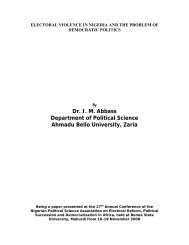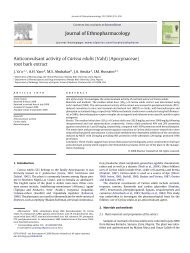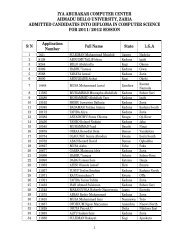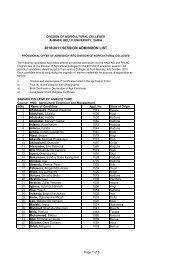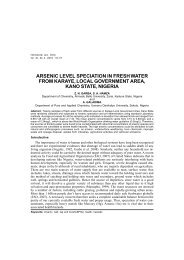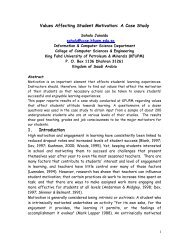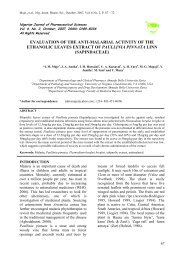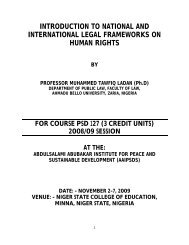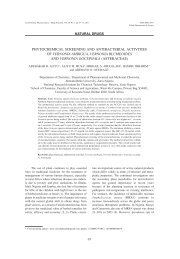Full Paper [PDF] - Ahmadu Bello University
Full Paper [PDF] - Ahmadu Bello University
Full Paper [PDF] - Ahmadu Bello University
You also want an ePaper? Increase the reach of your titles
YUMPU automatically turns print PDFs into web optimized ePapers that Google loves.
Yaro, et al., Nig. Journ. Pharm. Sci., October, 2007, Vol. 6 No. 2, P. 127 – 133<br />
Nigerian Journal of Pharmaceutical Sciences<br />
Vol. 6, No. 2, October, 2007, ISSN: 0189-823X<br />
All Rights Reserved<br />
BEHAVIOURAL EFFECTS OF METHANOL EXTRACT OF<br />
CHRYSANTHELLUM INDICUM IN MICE AND RATS<br />
1* Yaro, A. H., 2 Anuka, J. A., 3 Salawu, O. A., 2 Magaji, M. G.<br />
1 Department of Pharmacology, Faculty of Medicine, Bayero <strong>University</strong>, Kano, Nigeria<br />
2 Department of Pharmacology and Clinical Pharmacy, <strong>Ahmadu</strong> <strong>Bello</strong> <strong>University</strong>, Zaria, Nigeria<br />
3 National Institute for Pharmaceutical Research and Development (NIPRD), Abuja, Nigeria<br />
* Author for Correspondence: (yaroabdulng@yahoo.com)<br />
ABSTRACT<br />
The behavioural effects of methanol extract of Chrysanthellum indicum Linn. Vatke were studied on spontaneous<br />
motor activity (SMA), amphetamine and apomorphine-induced stereotype behaviour, pentobarbitone-induced<br />
hypnosis, exploratory activity and haloperidol-induced catalepsy in mice and rats. The Intraperitoneal and per oral<br />
LD 50 values were also estimated in mice. The intraperitoneal and oral acute toxicity values (LD 50 ) in mice were<br />
found to be 288.5 and 2154 mg/kg body weight respectively. The extract significantly decreased spontaneous motor<br />
activity (SMA) and antagonized apomorphine and amphetamine-induced stereotyped behaviour in mice dose and<br />
time dependently. The extract has no effect on the onset of pentibarbitone-induced sleep, but significantly prolonged<br />
the duration of pentobarbitone-induced sleep and enhanced haloperidol-induced catalepsy dose and time<br />
dependently. It also decreased exploratory activity in mice and had no effect on motor coordination. Our results<br />
provided evidence that the methanol extract of Chrysanthellum indicum contains psycho-active substance(s) with<br />
potential antipsychotic properties. Thus, supporting the development of active substances in the methanol extract for<br />
the treatment of psychoses.<br />
Key words: Chrysanthellum indicum, sleep, catalepsy, coordination, exploratory, sedation, psychoses.<br />
INTRODUCTION<br />
Remedies from plants play an important role<br />
in the healthcare of millions of people<br />
(Rukangira, 2001). Population increase,<br />
inadequate drug supply, exorbitant cost of<br />
treatments and side effects of several<br />
conventional drugs have led to increased<br />
emphasis on the use of plant materials as a<br />
source of medicines for a wide variety of<br />
human ailments including behavioural<br />
disorders.<br />
Majority of the plants used in traditional<br />
medicine lack scientific verification. Many<br />
medicinal plants are used in various ways<br />
because of their activities on the CNS.<br />
However, only limited efforts have been<br />
made to evaluate the potentials of such<br />
plants for their use in modern medicine or to<br />
scientifically justify their traditional use in<br />
the treatment of CNS disorders.<br />
Chrysanthellum indicum Linn. Vatke<br />
(Compositae) is a faintly aromatic herb that<br />
is widely distributed in the tropics. The plant<br />
is commonly known in Hausa as rariyar<br />
kasa (Kontagora), dunkufe (Zaria) and<br />
Goshin ba’ana and in southern Nigeria as<br />
oyigi or abilere in Yoruba (Dalziel, 1955).<br />
Locally in Likoro village of Kaduna state of<br />
Nigeria, the plant is used for the treatment of<br />
mental illness and convulsion (Adamu<br />
Mohammed, personal communication).<br />
The plant has been screened for a<br />
number of pharmacological activities<br />
including anti-tumour activity (Woo et al.,<br />
1977), antiamoebic, diuretic and<br />
127
Yaro, et al., Nig. Journ. Pharm. Sci., October, 2007, Vol. 6 No. 2, P. 127 – 133<br />
hypoglycemic activities (Dhar et al., 1973),<br />
antioxidant (Brasseur et al., 1987) and<br />
gastrointestinal (Amos et al., 2001)<br />
activities. To our knowledge, there is no<br />
report on the behavioural activities of the<br />
plant. This study was designed to test the<br />
behavioural properties of the methanol<br />
extract.<br />
MATERIALS AND METHODS<br />
Collection of plant materials<br />
The whole plant was collected from Likoro<br />
Village, in Kudan Local Government Area,<br />
Kaduna State, Nigeria, in September, 2006.<br />
The plant was identified and authenticated<br />
by staff of the Herbarium Section of<br />
Department of Biological Sciences, <strong>Ahmadu</strong><br />
<strong>Bello</strong> <strong>University</strong>, Zaria. A voucher<br />
specimen (No. 3110) was deposited at the<br />
herbarium for future reference.<br />
Preparation of extract<br />
The plant material was cleaned, air dried for<br />
7 days and then crushed into coarse powder<br />
with a pestle and mortar. About 100 g of the<br />
powered plant material was successively<br />
macerated with methanol for 48 hours with<br />
occasional shaking. The macerate was<br />
concentrated in vacuo to afford an average<br />
yield of 17.7%.w/w. It was subsequently<br />
referred to as the extract (CI).<br />
Animals<br />
Swiss albino mice (18-25 g) and Adult<br />
Wistar rats (180-220 g) of either sex<br />
obtained from the Animal House Unit,<br />
Department of Pharmacology and Clinical<br />
Pharmacy, <strong>Ahmadu</strong> <strong>Bello</strong> <strong>University</strong>, Zaria<br />
were used. The animals were maintained in<br />
a well ventilated room, fed on Excel feeds<br />
(Feed Masters, Ilorin) and water ad libitum.<br />
All experimental protocols were approved<br />
by the <strong>University</strong> animal ethics committee.<br />
Phytochemical Test<br />
The extract was screened for the presence of<br />
alkaloids, glycosides, tannins, saponins and<br />
flavonoids according to standard procedure<br />
(Trease and Evans, 1989).<br />
Acute Toxicity Studies in Mice<br />
LD 50 determination was conducted using the<br />
method previously described by Lorke<br />
(1983) for oral and intraperitoneal routes in<br />
mice.<br />
Spontaneous Motor Activity Testing in<br />
Mice<br />
The mice (n=6) were treated with either the<br />
extract (12.5, 25 and 50 mg/kg) or normal<br />
saline. Thirty minutes later, the mice were<br />
transferred individually to Letica Activity<br />
Cages (LE886) connected to a multicount<br />
(LE3806), and after 1min. latency period,<br />
activity counts were recorded for 6 minutes<br />
(Wambebe et al., 1997) at 30, 60, 90, and<br />
120 min.<br />
Amphetamine-induced Stereotyped<br />
Behaviour in Mice<br />
The mice (n=6) were treated with the<br />
extract (12.5, 25 and 50 mg/kg), normal<br />
saline (10 ml/kg) or chlorpromazine (2<br />
mg/kg). Thirty minutes later each mouse<br />
received 2mg amphetamine per kg<br />
intraperitoneally. The signs of stereotyped<br />
behaviour (jumping/climbing, limb licking<br />
and sniffing) were recorded for a period of 2<br />
hours (Ellinwood et al., 1973).<br />
Apomorphine-induced Stereotyped<br />
Behaviour in Mice<br />
The mice were (n=6) pretreated with either<br />
the extract (12.5, 25 and 50 mg/kg) or<br />
normal saline. Thirty minutes later, 2mg<br />
apomorphine per kg, i.p. was administered<br />
to the mice in all the groups. The mice were<br />
observed for signs of stereotypic behaviour<br />
(sniffing, jumping/climbing, and paw<br />
lickings) for two hours using hand tallies<br />
(Nemeroff, 1980).<br />
Pentobarbitone Sleeping Time in Mice<br />
The test was carried out in four groups of six<br />
mice each. The first three groups received<br />
12.5, 25.0 and 50.0mg extract per kg i.p.<br />
respectively, while the last group received<br />
normal saline (10 ml/kg) as control. Thirty<br />
minutes later, 30mg pentobarbitone sodium<br />
128
Yaro, et al., Nig. Journ. Pharm. Sci., October, 2007, Vol. 6 No. 2, P. 127 – 133<br />
per kg i.p. was administered to each mouse<br />
to induce sleep. Each mouse was observed<br />
for the onset and duration of sleep, with the<br />
criterion for sleep being loss of righting<br />
reflex (Rolland et al., 1991) while the<br />
interval between the loss and the recovery of<br />
righting reflex was regarded as the duration<br />
of sleep (Fujimori, 1965)<br />
Haloperidol-induced Catalepsy in Rats<br />
Adult Wistar rats were grouped into four<br />
(n=6) and pretreated with either the extract<br />
(12.5, 25 and 50 mg/kg) or normal saline (10<br />
ml/kg). Haloperidol at a dose of 2mg per kg<br />
i.p. was administered to the rats in each<br />
group thirty minutes after pretreatment with<br />
the extract and normal saline. The severity<br />
of catalepsy in each rat was measured every<br />
30 min for 180 min (3 hours). Catalepsy of<br />
an individual rat was measured in a stepwise<br />
manner by a scoring method as follow:<br />
Step I: Each rat was taken out of the cage<br />
and placed on a table. It was then pushed<br />
forward by a gentle touch on the back. If it<br />
failed to move when touched gently on the<br />
back or pushed, a score of 0.5 was assigned.<br />
Step II: the front paws of the rat were<br />
placed alternately on a 3cm high block. If<br />
the rats failed to correct the posture within<br />
15 seconds a score of 0.5 for each paw was<br />
added to the score of step I.<br />
Step III: the front paws of the rats were<br />
placed alternately on a 9cm high block. If<br />
the rat failed to correct the posture within 15<br />
seconds, a score of 1 for each paw was<br />
added to the scores in I and II Thus for an<br />
animal, the highest score was 3.5 (cut-off<br />
Score) and this reflects total catalepsy<br />
(Khisti et al., 1997).<br />
Test for Exploratory Behaviour in Mice<br />
The method used was as described by File<br />
(1973) and modified by Yemitan et al.<br />
(2001). The mice were grouped into 5<br />
(n=6). The apparatus used was a white<br />
painted wooden board (40cm x 40cm) with<br />
four equidistant holes (1cm diameter x 2cm<br />
depth). The animals were treated with the<br />
vehicle (normal saline), the extract (12.5, 25<br />
and 50 mg/kg) or diazepam (1 mg/kg), i.p.<br />
Thirty minutes later, each mouse was placed<br />
at one corner of the board and the number of<br />
head dips recorded over a period of 7.5 min<br />
(File and Wardill, 1975).<br />
Rota-rod Test for Motor Coordination<br />
A rota-rod treadmill device (Ugo Basile N0.<br />
7600, Varese, Italy) was used for this study.<br />
Mice were trained to remain on slowlymoving<br />
(16 revolutions/min) rods of 5cm<br />
diameter for 150 seconds. They were<br />
subsequently grouped into four (n=6) and<br />
treated with either the extract (12.5, 25 and<br />
50 mg/kg) or normal saline (1ml/kg). 30<br />
minutes post-treatment; animals were placed<br />
on the rod at intervals of 30 minutes, up to 2<br />
hours. If an animal failed more than once to<br />
remain on the rod for 3 minutes, it is<br />
considered to lack motor coordination.<br />
Statistical Analysis<br />
Results were expressed as mean ± standard<br />
error of mean; Student’s t-test was used to<br />
determine level of significance of all results<br />
obtained. Results were regarded as<br />
significant at P< 0.05.<br />
RESULTS<br />
The phytochemical screening of the extract<br />
revealed the presence of flavonoids, tannins,<br />
glycosides, alkaloids and steroids.<br />
The extract (12.5 – 50 mg/kg i.p.)<br />
caused a significant (P
Yaro, et al., Nig. Journ. Pharm. Sci., October, 2007, Vol. 6 No. 2, P. 127 – 133<br />
sleep, but significantly (P
Yaro, et al., Nig. Journ. Pharm. Sci., October, 2007, Vol. 6 No. 2, P. 127 – 133<br />
Table 4: Effect of Methanol Extract of C. indicum on Pentobarbitone-induced<br />
sleeping Time in Mice<br />
Treatment (mg/kg) Onset of sleep(min) Duration of Sleep (min)<br />
Normal Saline 4.3 ± 0.2 51.3 ± 6.8<br />
C.I. (12.5) 3.6 ± 0.5 57.8 ± 3.1<br />
C.I(25.0) 4.0 ± 0.3 71.8 ± 5.0 a<br />
C.I.(50.0) 3.6 ± 0.2 101.2 ± 5.5 c<br />
Diazepam (1) 3.2 ± 0.3 b 117.3 ± 4.6 c<br />
All the groups received Pentobarbitone sodium 30mg/kg i.p., Data Presented as<br />
Mean ±SEM, student’s t-test. n = 6, a, and c Are significantly different from<br />
control at P
Yaro, et al., Nig. Journ. Pharm. Sci., October, 2007, Vol. 6 No. 2, P. 127 – 133<br />
play an important role in sleep mechanism.<br />
It is probable that the extract prolonged the<br />
duration of pentobarbitone-induced sleep in<br />
mice via dopaminergic pathways or some<br />
other mechanisms that are related to sleep.<br />
The extract exacerbated haloperidolinduced<br />
catalepsy in rats. Catalepsy is a<br />
trance-like state of self hypnotic sleep<br />
during which there is long-term maintenance<br />
of an animal in an abnormal posture.<br />
Although, neuroleptic-induced catalepsy is<br />
primarily due to the blockade of<br />
dopaminergic<br />
neurotransmission<br />
(Baldessarini, 1990), a number of other<br />
neurotransmitter systems indirectly<br />
influence this response. Potentiation of<br />
haloperidol-induced catalepsy by the extract<br />
in this experiment may well be a simple<br />
synergistic effect of the extract and<br />
haloperidol. The hole-board experiment is a<br />
measure of exploratory behaviour in animals<br />
(File and Wardill (1975). A decrease in this<br />
parameter reveals a sedative behaviour (File<br />
and Pellow, 1985), which has also been<br />
accepted as a parameter for the evaluation of<br />
anxiety conditions, in animals (Crawley,<br />
1985). Reduction of exploratory behavior<br />
without undue sedation, induction of<br />
cataleptic state, inhibition of intracranial<br />
self-stimulation of reward areas, and<br />
prevention of apomorphine-induced<br />
vomiting are other tests that may predict<br />
antipsychotic action (Potter and Hollister,<br />
2004). The extract had no effects on motor<br />
coordination in the treadmill experiment,<br />
suggesting that inhibitory effects observed in<br />
the other studies might be elicited centrally<br />
and not due to a peripheral neuromuscular<br />
blockade. The therapeutic benefits of<br />
traditional remedies might depend upon a<br />
combination of constituents. Some of the<br />
constituents found in this extract might have<br />
contributed to the observed effects. For<br />
instance, alkaloids and saponins have been<br />
reported to show potent sedative activity,<br />
they have also been shown to have<br />
antagonistic activity on amphetamine and<br />
known to inhibit spontaneous motor activity<br />
in mice (Dubois et al., 1986; Taesotikul et<br />
al., 1998). It is therefore, likely that the<br />
alkaloids and saponins content of this plant<br />
might be contributing in part to these<br />
pharmacological effects of the extract.<br />
It may therefore be concluded, based<br />
on the data presented, that the use of<br />
Chrysanthellum indicum in traditional<br />
medicine in Nigeria and other West African<br />
countries is justifiable scientifically. The<br />
pharmacological activities of its active<br />
principles (flavonoids, alkaloids, tannins,<br />
and saponins) correlate very well with those<br />
of antipsychotic agents (e.g. haloperidol).<br />
Further research will involve the isolation of<br />
bioactive components responsible for the<br />
observed pharmacological activities.<br />
REFERENCES<br />
Amos, S., Binda, M., Adamu, M., Akah, P.,<br />
Wambebe, C., and Gamaniel, K. (2001).<br />
Cardiovascular effects of the aqueous extract of<br />
Chrysanthellum indicum. Journal of Natural<br />
Remedies. 1(2): 116 – 120.<br />
Anca, J. M., Lamela, M., and Calleja, J. M. (1993).<br />
Activity on the central nervous system of<br />
Himenthalia elongata. Planta medica. 5: 218–220.<br />
Baldessarini R. J. (1990).Drugs and the treatment of<br />
psychiatric disorders. In : The Pharmacological Basis<br />
of Therapeutics, 8 th edition (Alfred, G.G., Theodore,<br />
W.R., Alau, S. N. and Palmer, T. Eds. ) Pergamon<br />
press, New York. pp. 383-435.<br />
Brasseur, T., Angenot, L., Pincemail, J. and Derby,<br />
C. (1987). Action antiradical aire de flavonoides et<br />
d’ extract de Chrysanthellum indicum. Planta<br />
Medica. Phytother. 21:131-137.<br />
Crawley, J. N. (1985); Exploratory behavior models<br />
of anxiety in mice. Journal of Neuroscience and<br />
Behaviour. 9: 37-44.<br />
Dalziel, J. M. (1955). The useful plants of West<br />
Tropical Africa. Crown Agent for Overseas<br />
Government and Administration, London. Pp. 417.<br />
Dhar, M.L., Dhar, M.N., Dhawan, B.N., Mehrotra,<br />
B.N., Srimal, R.C. and Tandon, J.S. (1973);<br />
Screening of Indian Plants for Biological Activity.<br />
Part IV. Indian Journal of Experimental Biology.<br />
11:43-54.<br />
Dubois, M. A., Liyas, M., Wagner, H.<br />
(1986).Cussanoides A and B, two triterpene-saponins<br />
from Cussonia barteri. Planta Medica, 80-83.<br />
132
Yaro, et al., Nig. Journ. Pharm. Sci., October, 2007, Vol. 6 No. 2, P. 127 – 133<br />
Ellinwood, E.H., Sudilosky, B., and Nelson, L.M.<br />
(1973). Evolving behaviour in the clinical and<br />
experimental amphetamine (model) psychosis.<br />
American Journal of Psychiatry. 730:1088.<br />
File, S. and Pellow, S. (1985).The effect of<br />
triazolobenzodiazepines in two animal tests of<br />
anxiety and on the hole–board. British Journal of<br />
Pharmacology. 86:729–735.<br />
File, S. and Pellow, S. (1985).The effect of<br />
triazolobenzodiazepines in two animal tests of<br />
anxiety and on the hole–board. British Journal of<br />
Pharmacology. 86:729–735.<br />
File, S.E. and Wardill, A.G. (1975). Validity of headdipping<br />
as a measure of explorating a modified holeboard.<br />
Psychopharmacology. 44:53-59.<br />
Fujimori, H. (1965) Potentiation of barbital hypnosis<br />
as an evaluation method of central nervous system<br />
depressant. Psychopharmacology, 7: 374-397.<br />
Khisti, R.T., Mandhane, S.N. and Chopde, C.T.<br />
(1997). Haloperidol-induced catalepsy: a model for<br />
screening antidepressants effective in treatment of<br />
depression with parkinson’s disease. Indian Journal<br />
of Experimental Biology. 35:1297-1301.<br />
Kosten, T. R. (2004). Drugs of Abuse. In: Basic and<br />
Clinical Pharmacology, 9 th edition, (Betram, G. K.<br />
Eds). The McGraw Hill, Companies, Inc. Medical<br />
Publishing Division, pp. 521.<br />
Lorke, D. (1983). A new approach to practical acute<br />
toxicity testing. Archives of Toxicology. 54: 275-287.<br />
Nemeroff, C.B. (1980). Neurotensin, biologically<br />
active peptide. Biology and Psychiatry. 15:283-286.<br />
Potter, W. Z. and Hollister, L. E. (2004).<br />
Antipsychotic Agents and Lithium. In: Basic and<br />
Clinical Pharmcology, 9 th edition, (Betram, G. K.<br />
Eds). The McGraw-Hill Companies, Inc. Medical<br />
Publishing Division. pp. 468 – 469.<br />
Rolland, A., Fleurentain, J., Lanhers, M., Younos, C.,<br />
Misslin, R and Morier, F. (1991). Behavioural<br />
effects of American traditional plant Eschscholzia<br />
californica; sedative and anxiolytic properties.<br />
Planta Medica. 57:212-216.<br />
Rukangira, E. (2001) The African Herbal Industry:<br />
Constraints and challenges: A paper presented at the<br />
Natural products and cosmeceuticals conference.<br />
Taesotikul, A., Panthong A., Kajanapothi, D.,<br />
Verpoorte, R., Scheffer, J. J. C., (19980.<br />
Neuropharmacological activities of the crude<br />
alkaloidal fraction from stems of Tabernaemontana<br />
pandacaqui Poir Journal of Ethnopharmacology.<br />
62:229-234.<br />
Trease, G.E. and Evans, M.C. (1989). Textbook of<br />
Pharmacognosy, 13 th ed. Bailliere, Tindall, London,<br />
pp. 683-684.<br />
Wambebe, C., Gamaniel, K., Akah, P.A., Kapu, S.D.,<br />
Samson, A., Orisadipe, A.T. and Okogun, J.I. (1997).<br />
Central and Uterotonic effect of cycleanine. Indian<br />
Journal of Pharmacology. 29: 5366–5372.<br />
Woo, W.S., Lee, E.B. and Chang, I. (1977).<br />
Biological Evaluation of Korean Medicinal Plants II.<br />
Yakhak Hoe Chi. 21:177-183.<br />
Yemitan, O.K., Ajibade, A.M. and Adeyemi, O.O.<br />
(2001). Anticonvulsant Activity of Dalbergia<br />
saxatilis. Nigerian Journal of Neuroscience. Vol.4.<br />
33-39.<br />
133


![Full Paper [PDF] - Ahmadu Bello University](https://img.yumpu.com/24706459/1/500x640/full-paper-pdf-ahmadu-bello-university.jpg)
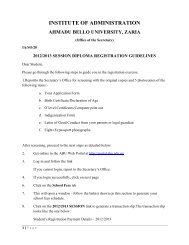
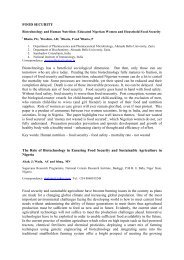
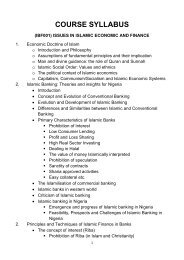
![Full Paper [PDF]](https://img.yumpu.com/49740055/1/184x260/full-paper-pdf.jpg?quality=85)
